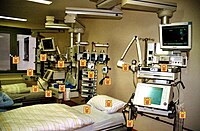
Photo from wikipedia
Importance Hospital engagement networks supported by the US Centers for Medicare & Medicaid Services Partnership for Patients program have reported significant reductions in hospital-acquired harm, but methodological limitations and lack… Click to show full abstract
Importance Hospital engagement networks supported by the US Centers for Medicare & Medicaid Services Partnership for Patients program have reported significant reductions in hospital-acquired harm, but methodological limitations and lack of peer review have led to persistent questions about the effectiveness of this approach. Objective To evaluate associations between membership in Children's Hospitals' Solutions for Patient Safety (SPS), a federally funded hospital engagement network, and hospital-acquired harm using standardized definitions and secular trend adjustment. Design, Setting, and Participants This prospective hospital cohort study included 99 children's hospitals. Using interrupted time series analyses with staggered intervention introduction, immediate and postimplementation changes in hospital-acquired harm rates were analyzed, with adjustment for preexisting secular trends. Outcomes were further evaluated by early-adopting (n = 73) and late-adopting (n = 26) cohorts. Exposures Hospitals implemented harm prevention bundles, reported outcomes and bundle compliance using standard definitions to the network monthly, participated in learning events, and implemented a broad safety culture program. Hospitals received regular reports on their comparative performance. Main Outcomes and Measures Outcomes for 8 hospital-acquired conditions were evaluated over 1 year before and 3 years after intervention. Results In total, 99 hospitals met the inclusion criteria and were included in the analysis. A total of 73 were considered part of the early-adopting cohort (joined between 2012-2013) and 26 were considered part of the late-adopting cohort (joined between 2014-2016). A total of 42 hospitals were freestanding children's hospitals, and 57 were children's hospitals within hospital or health systems. The implementation of SPS was associated with an improvement in hospital-acquired condition rates in 3 of the 8 conditions after accounting for secular trends. Membership in the SPS was associated with an immediate reduction in central catheter-associated bloodstream infections (coefficient = -0.152; 95% CI, -0.213 to -0.019) and falls of moderate or greater severity (coefficient = -0.331; 95% CI, -0.594 to -0.069). The implementation of the SPS was associated with a reduction in the monthly rate of adverse drug events (coefficient = -0.021; 95% CI, -0.034 to -0.008) in the post-SPS period. The study team observed larger decreases for the early-adopting cohort compared with the late-adopting cohort. Conclusions and Relevance Through the application of rigorous methods (standard definitions and longitudinal time series analysis with adjustment for secular trends), this study provides a more thorough analysis of the association between the Partnership for Patients hospital engagement network model and reductions in hospital-acquired conditions. These findings strengthen previous claims of an association between this model and improvement. However, inconsistent observations across hospital-acquired conditions when adjusted for secular trends suggests that some caution regarding attributing all effects observed to this model is warranted.
Journal Title: JAMA pediatrics
Year Published: 2022
Link to full text (if available)
Share on Social Media: Sign Up to like & get
recommendations!